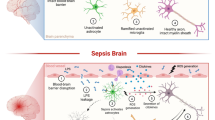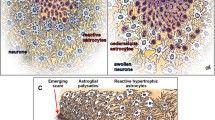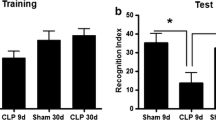Abstract
Neonatal sepsis is common in neonatal intensive care units, often complicated by injury to the immature brain. Previous studies have shown that the expression of the gap junction protein connexin 43 (Cx43) in the brain decreases when stimulated by neuro-inflammatory drugs such as lipopolysaccharide (LPS). Here we showed that partial deletion of Cx43 in astrocytes resulted in weakened inflammatory responses. The up-regulation of pro-inflammatory cytokines was significantly reduced in mice with partial deletion of Cx43 in astrocytes compared with wild-type littermates after systemic LPS injection. Moreover, microglial activation was inhibited in mice with partial deletion of Cx43. These results showed that Cx43 in astrocytes plays a critical role in neuro-inflammatory responses. This work provides a potential therapeutic target for inhibiting neuro-inflammatory responses in neonatal sepsis.
Similar content being viewed by others
References
Bakhuizen SE, de Haan TR, Teune MJ, van Wassenaer-Leemhuis AG, van der Heyden JL, van der Ham DP, et al. Meta-analysis shows that infants who have suffered neonatal sepsis face an increased risk of mortality and severe complications. Acta Paediatr 2014, 103: 1211–1218.
Camacho-Gonzalez A, Spearman PW, Stoll BJ. Neonatal infectious diseases evaluation of neonatal sepsis. Pediatr Clin North Am 2013, 60: 367–389.
Strunk T, Inder T, Wang X, Burgner D, Mallard C, Levy O. Infection-induced inflammation and cerebral injury in preterm infants. Lancet Infect Dis 2014, 14: 751–762.
Hagberg H, Gressens P, Mallard C. Inflammation during fetal and neonatal life: implications for neurologic and neuropsychiatric disease in children and adults. Ann Neurol 2012, 71: 444–457.
Lee I, Neil JJ, Huettner PC, Smyser CD, Rogers CE, Shimony JS, et al. The impact of prenatal and neonatal infection on neurodevelopmental outcomes in very preterm infants. J Perinatol 2014, 34: 741–747.
Aden U, Favrais G, Plaisant F, Winerdal M, Felderhoff- Mueser U, Lampa J, et al. Systemic inflammation sensitizes the neonatal brain to excitotoxicity through a pro-/antiinflammatory imbalance: key role of TNFalpha pathway and protection by etanercept. Brain Behav Immun 2010, 24: 747–758.
Hong HK, Lee HJ, Ko JH, Park JH, Park JY, Choi CW, et al. Neonatal systemic inflammation in rats alters retinal vessel development and simulates pathologic features of retinopathy of prematurity. J Neuroinflammation 2014, 11: 87.
Harry GJ. Neuroinflammation: a need to understand microglia as resident cells of the develo** brain. Neurotoxicology 2012, 33: 558–559.
Harry GJ, Kraft AD. Microglia in the develo** brain: A potential target with lifetime effects. Neurotoxicology 2012, 33: 191–206.
Carson MJ, Doose JM, Melchior B, Schmid CD, Ploix CC. CNS immune privilege: hiding in plain sight. Immunol Rev 2006, 213: 48–65.
Ransohoff RM, Perry VH. Microglial physiology: unique stimuli, specialized responses. Ann Rev Immunol 2009, 27: 119–145.
Gomez-Gonzalez B, Escobar A. Prenatal stress alters microglial development and distribution in postnatal rat brain. Acta Neuropathologica 2010, 119: 303–315.
Masuda T, Croom D, Hida H, Kirov SA. Capillary blood flow around microglial somata determines dynamics of microglial processes in ischemic conditions. Glia 2011, 59: 1744–1753.
Chung WS, Barres B. The role of glial cells in synapse elimination. Curr Opin Neurobiol 2012, 22: 438–445.
Allaman I, Belanger M, Magistretti PJ. Astrocyte-neuron metabolic relationships: for better and for worse. Trends Neurosci 2011, 34: 76–87.
Mayo L, Trauger SA, Blain M, Nadeau M, Patel B, Alvarez JI, et al. Regulation of astrocyte activation by glycolipids drives chronic CNS inflammation. Nat Med 2014, 20: 1147–1156.
Barinfeld S, Filipovich-Rimon T, Fleisher-Berkovich S. Astrocyte inflammation: possible role for kinins. J Mol Neurosci 2013, 51: S17–S17.
Evans WH, de Vuyst E, Leybaert L. The gap junction cellular internet: connexin hemichannels enter the signalling limelight. Biochem J 2006, 397: 1–14.
Elias LAB, Wang DD, Kriegstein AR. Gap junction adhesion is necessary for radial migration in the neocortex. Nature 2007, 448: 901–903.
Le HT, Sin WC, Lozinsky S, Bechberger J, Vega JL, Guo XQ, et al. Gap junction intercellular communication mediated by Connexin43 in astrocytes is essential for their resistance to oxidative stress. J Biol Chem 2014, 289: 1345–1354.
Liao CK, Wang SM, Chen YL, Wang HS, Wu JC. Lipopolysaccharide-induced inhibition of connexin43 gap junction communication in astrocytes is mediated by downregulation of caveolin-3. Int J Biochem Cell Biol 2010, 42: 762–770.
Liao CK, Jeng CJ, Wang HS, Wang SH, Wu JC. Lipopolysaccharide induces degradation of connexin43 in rat astrocytes via the ubiquitin-proteasome proteolytic pathway. PLoS One 2013, 8: e79350.
Ming Z, Wotton CA, Appleton RT, Ching JC, Loewen ME, Sawicki G, et al. Systemic lipopolysaccharide-mediated alteration of cortical neuromodulation involves increases in monoamine oxidase-A and acetylcholinesterase activity. J Neuroinflammation 2015, 12: 37.
Davalos D, Grutzendler J, Yang G, Kim JV, Zuo Y, Jung S, et al. ATP mediates rapid microglial response to local brain injury in vivo. Nat Neurosci 2005, 8: 752–758.
Hines DJ, Hines RM, Mulligan SJ, Macvicar BA. Microglia processes block the spread of damage in the brain and require functional chloride channels. Glia 2009, 57: 1610–1618.
Huang C, Han X, Li X, Lam E, Peng W, Lou N, et al. Critical role of connexin 43 in secondary expansion of traumatic spinal cord injury. J Neurosci 2012, 32: 3333–3338.
Vázquez C, Tolón RM, Pazos MR, Moreno M, Koester EC, Cravatt BF, et al. Endocannabinoids regulate the activity of astrocytic hemichannels and the microglial response against an injury: In vivo studies. Neurobiol Dis 2015, 79: 41–50.
Abudara V, Roux L, Dallerac G, Matias I, Dulong J, Mothet JP, et al. Activated microglia impairs neuroglial interaction by opening Cx43 hemichannels in hippocampal astrocytes. Glia 2015, 63: 795–811.
Retamal MA, Froger N, Palacios-Prado N, Ezan P, Saez PJ, Saez JC, et al. Cx43 hemichannels and gap junction channels in astrocytes are regulated oppositely by proinflammatory cytokines released from activated microglia. J Neurosci 2007, 27: 13781–13792.
Author information
Authors and Affiliations
Corresponding author
Rights and permissions
About this article
Cite this article
Zhou, JJ., Cheng, C., Qiu, Z. et al. Decreased connexin 43 in astrocytes inhibits the neuroinflammatory reaction in an acute mouse model of neonatal sepsis. Neurosci. Bull. 31, 763–768 (2015). https://doi.org/10.1007/s12264-015-1561-5
Received:
Accepted:
Published:
Issue Date:
DOI: https://doi.org/10.1007/s12264-015-1561-5




